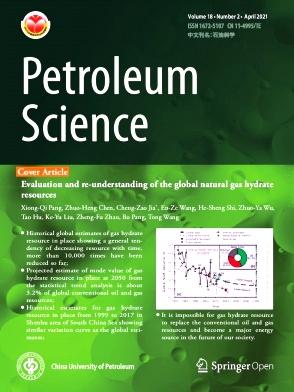Mobilization of tight oil by spontaneous imbibition of surfactants
IF 6
1区 工程技术
Q2 ENERGY & FUELS
引用次数: 0
Abstract
A series of spontaneous imbibition (SI) tests of tight oil were performed, together with oil distribution scans by computed tomography (CT) and nuclear magnetic resonance (NMR). Thus, the best surfactants to optimize the SI effect were obtained, the basic requirements to surfactants for efficient SI were determined, and the oil mobilization by SI revealed. The results show that anionic surfactants significantly outperform non-ionic, cationic, and zwitterionic ones in SI process. Excellent systems can be further obtained by mixing anionic surfactants with others (e.g. 1:1 mixtures of AES:EHSB). The requirements to interfacial properties of surfactants for achieving efficient SI at permeabilities of 0.05, 0.5, and 5.0 mD are as follows: 100 mN/m, < 40°; 10−1–100 mN/m, < 55°; and 10−1–100 mN/m, < 70°, respectively. Although a high oil recovery of 38.5% by SI was achieved in small cylindrical cores (ϕ2.5 cm × 3.0 cm), the joint SI and CT tests in larger, cube-shaped cores (5.0 cm × 5.0 cm × 5.0 cm) showed that the SI process could only remove the oil from the outermost few millimeters of the cores with permeabilities of 0.05 and 0.1 mD, indicating the great difficulty encountered for their development. The NMR showed that the SI treatment preferentially removed oil from smaller pores rather than medium or large pores.
通过表面活性剂的自发浸润开采致密油
对致密油进行了一系列自发浸润(SI)试验,并通过计算机断层扫描(CT)和核磁共振(NMR)对油分布进行了扫描。因此,获得了优化 SI 效果的最佳表面活性剂,确定了高效 SI 对表面活性剂的基本要求,并揭示了 SI 的石油动用情况。结果表明,阴离子表面活性剂在 SI 过程中的表现明显优于非离子、阳离子和齐聚物表面活性剂。通过将阴离子表面活性剂与其他表面活性剂混合(如 AES:EHSB 的 1:1 混合物),可进一步获得优异的体系。在渗透率为 0.05、0.5 和 5.0 mD 时,要实现高效的 SI,对表面活性剂界面特性的要求如下:分别为 10 mN/m,< 40°;10-10 mN/m,< 55°;10-10 mN/m,< 70°。虽然在小型圆柱形岩芯(2.5 厘米 × 3.0 厘米)中,SI 工艺的石油采收率高达 38.5%,但在大型立方体岩芯(5.0 厘米 × 5.0 厘米 × 5.0 厘米)中进行的 SI 和 CT 联合试验表明,SI 工艺只能清除渗透率为 0.05 和 0.1 mD 的岩芯最外层几毫米的石油,这表明其开发遇到了很大困难。核磁共振显示,SI 处理更倾向于清除较小孔隙中的油,而不是中孔或大孔隙中的油。
本文章由计算机程序翻译,如有差异,请以英文原文为准。
求助全文
约1分钟内获得全文
求助全文
来源期刊

Petroleum Science
地学-地球化学与地球物理
CiteScore
7.70
自引率
16.10%
发文量
311
审稿时长
63 days
期刊介绍:
Petroleum Science is the only English journal in China on petroleum science and technology that is intended for professionals engaged in petroleum science research and technical applications all over the world, as well as the managerial personnel of oil companies. It covers petroleum geology, petroleum geophysics, petroleum engineering, petrochemistry & chemical engineering, petroleum mechanics, and economic management. It aims to introduce the latest results in oil industry research in China, promote cooperation in petroleum science research between China and the rest of the world, and build a bridge for scientific communication between China and the world.
 求助内容:
求助内容: 应助结果提醒方式:
应助结果提醒方式:


